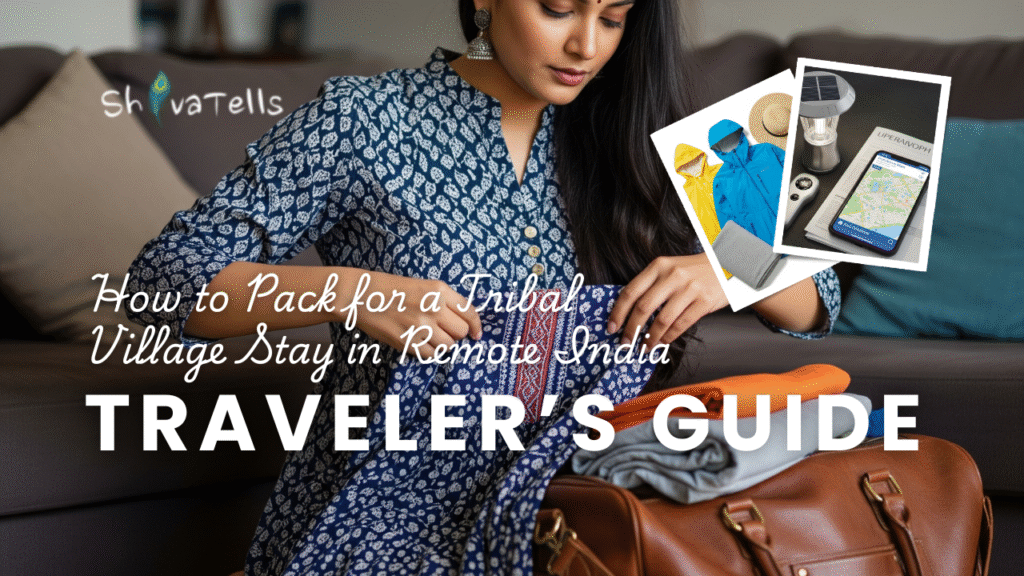There is a special kind of silence when you enter a tribal village deep inside India’s forests or hills. It’s not empty — it’s full of stories, ancient rhythms, and living traditions that have survived centuries. The air smells of earth and wood smoke. The people move with calm purpose, living close to nature’s heartbeat.
Preparing for this kind of journey is very different from packing for a city or beach holiday. When I first set out to visit tribal villages across Odisha and Nagaland, I learned that the right kind of packing means more than just clothes and gadgets — it means packing respect, openness, and simplicity.
If you dream of walking into these timeless places — from the dense forests of Bastar to the serene valleys of Ziro — here’s how you can prepare your bag and mind for the adventure.

Table of Contents
Dress with Respect: Blending Comfort and Tradition

In tribal India, clothing is a silent language. It shows your respect for the culture and your willingness to be part of the community, even if just for a few days.
Choose soft, breathable fabrics like cotton to stay comfortable in the warm, humid climate. Make sure your shoulders and knees are covered—this is more than modesty; it’s about honoring local customs. Avoid bright colors or flashy prints. Earth tones like browns, greens, and muted blues work best to blend into the natural surroundings.
Bring loose pants or long skirts because these allow easy movement and suit the relaxed village lifestyle. Nights can be surprisingly cool, especially in hill areas like Arunachal Pradesh or Nagaland, so a light sweater or shawl is a must. For footwear, pack sturdy sandals for walking outside, but also keep simple slippers for sitting indoors, especially when you spend time on mats or wooden floors.
A scarf or shawl is useful—it can protect your head from the sun, shield your face from dust, or cover you when visiting sacred spaces.
Essentials for Life Off the Grid

Life in tribal villages often means limited access to electricity, markets, or mobile networks. So, packing smart becomes your lifeline.
A reliable headlamp or flashlight with extra batteries is invaluable for moving around after dark. Since electricity can be scarce, a solar-powered charger or power bank helps keep your devices alive when you can find a signal.
Carry a reusable water bottle and purification tablets or a Lifestraw to ensure you have safe drinking water. Water sources might not always be clean, and bottled water is often unavailable.
Bring eco-friendly toiletries like biodegradable soap and toothpaste to respect the fragile environment. A small first aid kit with basics like antiseptic cream, bandages, and medicines for common ailments is essential.
Pack some dry snacks or energy bars. Travel in remote areas can mean unexpected delays and long waits, and having your own food can be a lifesaver.
Mosquitoes are common, so mosquito repellent and a small mosquito net are wise additions. Finally, a notebook and pen are perfect for jotting down stories, sketches, or words from your new friends — your phone might be useless in many places.
Respect in Your Bag: Gifts and Good Manners

Packing isn’t just about things. It’s about mindset.
Small gifts are a beautiful way to thank your hosts and start conversations. Seeds, spices, or simple handmade crafts from your home region are thoughtful choices. Children often love notebooks or pencils.
Bring a cloth bag to carry local purchases and avoid plastic waste. Avoid carrying expensive gadgets or jewelry—these can create discomfort or unwanted attention.
Remember, many tribal people follow oral traditions and deeply spiritual beliefs. Always ask permission before taking photos. Never touch sacred or ritual objects. Greet the village elders first; it’s a sign of respect and will open many doors.
Tech and Sustainability: Less Is More

In many tribal areas, power is precious. Traveling light and eco-friendly isn’t just trendy here — it’s necessary.
Pack a hand-crank torch or solar lamp for power outages. Download offline maps or carry printed directions since internet coverage is patchy or nonexistent.
Bring a paperback book, cards, or journal for entertainment instead of relying on screens. Avoid single-use plastics; use reusable containers and bags to keep the environment pristine.
These lands are often ecological sanctuaries where rivers, trees, and animals are sacred. The smallest footprint shows your respect.
Weather and Timing: Prepare for Nature’s Mood

October to March is the best time to visit tribal villages. You’ll avoid heavy monsoon rains and be there for festivals full of music, dance, and color — like the Gond dance in Bastar or the Apatani harvest celebrations.
Still, pack for surprises: a rain poncho or waterproof jacket is a must. Bring a hat or cap for sun protection and a light blanket or sleeping bag liner for chilly nights.
Ask your homestay hosts ahead about bedding and bathroom facilities. Many homes are simple, with open-air bathrooms and shared spaces.
The Most Important Things You Can Carry
The most essential packing is invisible. Carry your:
- Curiosity instead of judgment
- Patience instead of schedules
- Open ears instead of constant talking
Tribal villages follow rhythms of nature — not clocks. Sit by the fire. Learn songs from the elders. Help prepare meals. This is how you truly belong, even briefly.
ShivaTells’ Recommended Tribal Villages to Visit
- Odisha: Rayagada and Koraput, home to the Saura and Dongria Kondh tribes
- Chhattisgarh: Bastar and Kanker, where Gond and Muria communities live
- Nagaland: Longwa and Mokokchung, villages of Ao and Konyak tribes
- Arunachal Pradesh: Ziro and Pasighat, known for Apatani and Adi tribes
Travel Respectfully
- Use local guides or connect with NGOs to learn authentically
- Learn a few words in the local language to break the ice
- Never pay for photos or favors
- Always ask before joining rituals or meals
Final Thoughts:
On my last day in a tribal village, I was gifted a small wooden spoon. It was simple and rough but made by hand and full of meaning.
A tribal village stay isn’t about souvenirs you buy. It’s about stories, connections, and lessons you carry home. So pack lightly, with respect and gratitude. Carry an open heart.
Because when you step into these villages, among ancient trees and drumbeats, you aren’t just visiting—you become part of a living history.
Other stories from Assam
- This Man from Assam lives and loves ORCHIDS!
- Strange Indian TRADITIONS | Rare Turtles are offered in this TEMPLE of ASSAM
